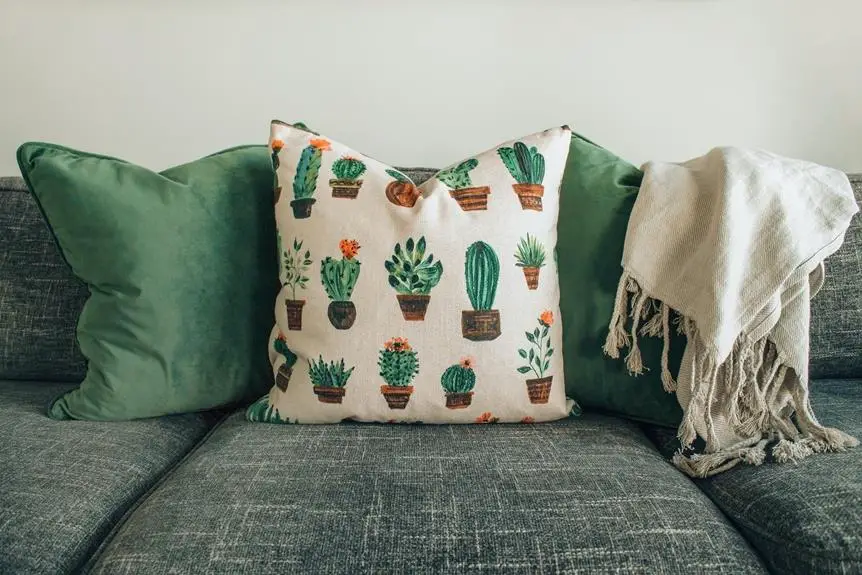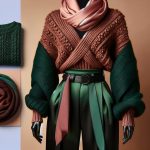When it comes to choosing fabrics that complement green, it's like finding the perfect harmony in a symphony. Understanding the various tones of green is essential for mastering the art of fabric selection.
From earthy olive to vibrant emerald, each shade requires careful consideration of fabric type, texture, and pattern. Mastery in this area involves exploring a range of fabrics, from luxurious silks to durable denims, and understanding how they interact with different green hues.
This guide will provide you with detailed insights on selecting the right fabrics to enhance the beauty of green in your interior design or wardrobe, while also offering tips on care and maintenance to ensure longevity.
Key Takeaways
- Consider the undertones and variations in different shades of green
- Pair fabrics with green by finding complementary textures and patterns
- Opt for fabrics made from natural fibers like cotton, linen, or silk
- Choose fabrics with subtle green undertones to enhance earthy greens
Understanding Green Color Tones
Understanding green color tones involves analyzing the undertones and variations present in different shades of green. Green, being a mixture of blue and yellow, can have warm or cool undertones. The undertones can greatly affect the overall feel of the color. For instance, a green with more blue undertones will appear cooler, while a green with more yellow undertones will appear warmer. This understanding is crucial when considering fabric selection and pairing with green.
In color psychology, green is often associated with nature, growth, and harmony. Lighter greens can evoke feelings of tranquility and freshness, while darker greens can convey a sense of stability and sophistication. When choosing fabrics to complement green, it's important to consider the symbolism of the color and how it aligns with the intended message of the design.
Fabric selection should take into account the desired mood and symbolism, as well as the specific shade of green being used. Pairing fabrics with green involves finding complementary textures and patterns that enhance the overall aesthetic. Understanding the intricacies of green color tones allows for more intentional and effective fabric choices when working with this versatile color.
Selecting Fabrics for Earthy Greens
When selecting fabrics for earthy greens, it's important to consider the undertones present in the fabric. Whether it's a warm or cool undertone, these subtle differences can greatly impact how the fabric complements green.
Additionally, pay attention to the texture and sheen of the fabric as they can enhance or detract from the overall look when paired with earthy greens.
Lastly, exploring complementary color palettes can help you find fabrics that not only complement green but also create a harmonious and balanced aesthetic.
Green Undertones in Fabrics
To complement earthy greens, consider selecting fabrics with subtle green undertones that enhance the natural feel of the color. When choosing fabrics with green undertones, keep in mind the following:
- Natural Fibers: Opt for fabrics made from natural fibers like cotton, linen, or silk, as these materials often have a more organic and earthy texture, enhancing the overall appearance of earthy green tones.
- Earthy Neutrals: Look for fabrics in earthy neutrals such as beige, tan, or olive with hints of green undertones. These colors work harmoniously with earthy greens, creating a cohesive and nature-inspired palette.
- Subdued Patterns: Select fabrics with subdued patterns that incorporate green undertones, such as botanical prints or subtle geometric designs. These patterns can add visual interest while maintaining a natural and tranquil aesthetic.
Texture and Sheen Considerations
Consider the texture and sheen of fabrics when selecting those that complement earthy greens. Texture and color play a significant role in how a fabric interacts with light and influences the overall appearance of the garment or decor. Fabrics with a matte texture can soften the look of earthy greens, while those with a more pronounced texture can add depth and visual interest. Similarly, the sheen of a fabric affects how it reflects light, thereby impacting the perception of the color. Fabrics with a subtle sheen can enhance the richness of earthy greens, while those with a high sheen can create a more formal and luxurious aesthetic. When considering sheen and drape, keep in mind that certain fabrics may possess both qualities, contributing to a versatile and elegant look.
| Texture and Color | Sheen and Drape |
|---|---|
| Matte textures can soften earthy greens | Subtle sheen enhances the richness of greens |
| Pronounced textures add depth and visual interest | High sheen creates a formal and luxurious aesthetic |
| Certain fabrics possess both sheen and drape, offering versatility and elegance |
Complementary Color Palettes
Select fabrics that complement earthy greens by considering a harmonious color palette. Understanding color psychology and fabric choices is crucial when selecting textiles to enhance the beauty of green hues in your interior design or fashion project. For earthy greens, you'll want to create a complementary color palette that brings out the best in this natural shade.
When choosing fabrics, keep in mind the following:
- Warm Neutrals: Opt for fabrics in warm neutral tones such as sand, camel, or terracotta to create a cozy and inviting atmosphere.
- Earthy Tones: Consider fabrics in earthy tones like rust, mustard, or olive to add depth and richness to your space or outfit.
- Subtle Patterns: Look for fabrics with subtle patterns in complementary colors to add visual interest without overwhelming the green color scheme.
Understanding green color psychology and fabric selection will enable you to curate a cohesive and visually appealing design.
Choosing Fabrics for Vibrant Greens
When choosing fabrics for vibrant greens, consider the undertones to ensure a perfect match with the shade of green.
The texture and shine of the fabric can also enhance the vibrancy of the green, adding depth and visual interest to the overall look.
Additionally, pay attention to the scale and type of patterns on the fabric to complement the boldness of the vibrant green.
Green Fabric Undertones
For vibrant greens, consider choosing fabrics with blue undertones to enhance the richness of the color. This choice aligns with color psychology as blue undertones create a harmonious and visually appealing contrast with vibrant greens.
When selecting fabrics with blue undertones, keep in mind that these undertones are often achieved through specific fabric dyes. Look for fabrics dyed with deep indigo or cool teal shades to complement vibrant greens effectively.
Additionally, fabrics with blue undertones can help to balance the overall appearance of the garment or interior decor, making the green color stand out more prominently.
Keep in mind that a subtle touch of blue in the fabric can make a significant difference in how the vibrant green is perceived, adding depth and intensity to the overall aesthetic.
Texture and Shine
When seeking fabrics that complement vibrant greens, look for options with both texture and shine to enhance the richness and depth of the color. Fabric finishes and luster play a crucial role in amplifying the visual appeal of vibrant green fabrics. Consider textiles with a glossy finish as they can add a luxurious sheen to the fabric, enhancing the depth and vibrancy of the green hue. Additionally, the tactile quality of the fabric can contribute to its overall luster. Fabrics with a smooth, polished texture tend to reflect light more effectively, thereby intensifying the vibrancy of the green color. Keep in mind that the interplay between textile tactility and glossiness can significantly impact how the fabric complements the vibrant greens in your design projects.
| Fabric Finishes | Examples |
|---|---|
| Matte | Cotton, Linen |
| Sheen | Satin, Silk |
| Glossy | Velvet, Taffeta |
Pattern Scale and Type
To complement vibrant greens, consider the scale and type of patterns in your fabric selection to enhance the overall visual impact of your design. When working with vibrant greens, pattern scale and type play a crucial role in creating a harmonious and visually appealing aesthetic. Here's what to keep in mind:
- Color psychology and design principles: Opt for patterns that complement vibrant greens such as complementary or analogous colors to create a balanced and visually pleasing design.
- Fabric weight and drape characteristics: Consider the weight and drape of the fabric when selecting patterns. Lighter weight fabrics are well-suited for smaller scale patterns, while heavier fabrics can handle larger scale patterns without overpowering the vibrant green color.
- Pattern type: Choose patterns that align with the overall design style, whether it's traditional, modern, or eclectic, to ensure a cohesive and polished look.
Exploring Textures and Patterns
When choosing fabrics that complement green, you should consider how textures and patterns can enhance the overall look of your space. Texture variety adds depth and visual interest to your decor. Incorporating different textures such as smooth, rough, shiny, or matte can create a dynamic and inviting atmosphere.
For instance, pairing a soft velvet upholstery with a nubby tweed throw can bring richness and dimension to a room adorned with green accents.
Similarly, pattern coordination is crucial in achieving a cohesive and aesthetically pleasing design. When working with green, consider botanical or nature-inspired patterns to harmonize with the color scheme. Additionally, geometric patterns can provide a modern and structured feel, while traditional floral motifs can infuse a timeless elegance into the space.
Mixing and matching patterns with varying scales, such as pairing a large-scale floral print with a small-scale geometric design, can add visual intrigue without overwhelming the eye.
Considering Fabric Durability
As you explore textures and patterns for fabrics that complement green, also consider the durability of the fabrics, ensuring they'll withstand the demands of your space.
When assessing fabric durability, several key factors should be taken into account:
- Fabric Longevity and Sustainability: Look for fabrics that are known for their longevity and sustainability. High-quality natural fibers such as cotton, linen, and wool are often good choices as they're durable and sustainable, making them suitable for long-term use.
- Colorfastness and Stain Resistance: It's essential to choose fabrics that are colorfast and resistant to stains. This ensures that the fabric maintains its color vibrancy over time and is less prone to staining, making it easier to maintain and clean.
- Abrasion Resistance: Consider the level of abrasion resistance the fabric offers. Fabrics with high abrasion resistance are more durable and can withstand wear and tear, making them particularly suitable for high-traffic areas.
Mixing and Matching Fabric Types
Consider both the weight and texture of different fabrics when mixing and matching for a cohesive look in your green-themed space. Mixing patterns and coordinating colors can create a dynamic and visually interesting environment.
When combining fabric types, it's essential to consider the overall aesthetic you want to achieve. For example, pairing a heavy, textured fabric like velvet with a lighter, smoother fabric such as silk can add depth and contrast to your space.
Additionally, consider the functionality of each fabric type. For upholstery, durable and stain-resistant fabrics like microfiber or canvas may be more suitable, while for drapery, sheer and lightweight fabrics like organza or chiffon can add an elegant touch.
When mixing fabrics, ensure that their colors complement each other and that the patterns, if any, work harmoniously together. For instance, pairing a solid-colored linen sofa with patterned throw pillows in shades of green can create a balanced and cohesive look.
Accessorizing With Green Fabrics
Create a cohesive and visually appealing space by accessorizing with green fabrics that complement your existing decor. When it comes to accessorizing with green fabrics, there are several trends and sustainable choices to consider.
- Green Fabric Trends, Styling:
Incorporate green fabrics in the form of throw pillows, curtains, or an accent chair. Opt for trending shades of green such as emerald, sage, or olive to add a contemporary touch to your space. Mix and match different textures like velvet, linen, or cotton to create depth and visual interest.
- Sustainable Fabric Choices, Impact:
Consider choosing sustainable fabrics like organic cotton, hemp, or recycled polyester for your green accessories. These choices not only contribute to a healthier environment but also add a unique and eco-friendly element to your decor. Look for fabrics that are certified by organizations like Global Organic Textile Standard (GOTS) or OEKO-TEX for added assurance of sustainable practices.
Care and Maintenance Tips
How do you ensure that your green fabrics maintain their color vibrancy and texture over time? Proper care and maintenance are essential to preserve the beauty and quality of your green fabrics. Follow these tips to keep your fabrics looking fresh and vibrant for years to come.
| Category | Tips |
|---|---|
| Stain removal | Act quickly to blot stains with a clean cloth. Avoid rubbing, which can set the stain. Use a gentle detergent and cold water for washing. For tough stains, consult a professional cleaner. |
| Fabric protection | Consider applying a fabric protector to repel stains and liquids. Always test on a small, inconspicuous area first. Reapply the protector after washing or dry cleaning. |
| Storage | Store green fabrics in a cool, dry place away from direct sunlight to prevent color fading. Avoid hanging delicate fabrics to prevent stretching. Use acid-free tissue paper for long-term storage. |
Frequently Asked Questions
Can I Use Green Fabrics in a Room With a Lot of Natural Light Without Worrying About Fading?
You can use green fabrics in a room with lots of natural light without worrying about fading. Choose durable, fade-resistant fabrics like cotton, linen, or polyester to maintain a calming atmosphere in the space.
Are There Any Specific Fabric Types That Are Best for Creating a Calming and Serene Atmosphere With Green Tones?
For creating a calming and serene atmosphere with green tones, consider using natural fabrics like linen, cotton, and silk. These fabrics complement green hues and can enhance the tranquil ambiance in a room with abundant natural light.
How Can I Incorporate Green Fabrics Into a Minimalist or Modern Design Aesthetic?
When incorporating green fabrics into industrial design, opt for sleek, textured materials like velvet or linen. For modern interiors, consider a color palette of sage, olive, and emerald to create a fresh and sophisticated look.
What Are Some Creative Ways to Mix and Match Different Green Fabrics in a Room?
When mixing patterns and coordinating colors, consider using different shades of green to create depth and visual interest. Experiment with textures like velvet, linen, and silk to add dimension to the room.
Are There Any Special Care Tips for Maintaining the Vibrancy of Green Fabrics Over Time?
To maintain the vibrancy of green fabrics over time, it's important to prioritize colorfastness and fabric protection. Regularly cleaning according to care instructions, avoiding direct sunlight, and using fabric protectants can significantly extend fabric longevity.
- How Does Ring Spun Cotton Affect Garment Fit and Shape Retention? - August 13, 2024
- What Are the Challenges in Producing Ring Spun Cotton? - August 13, 2024
- Is Ring Spun Cotton Suitable for Plus-Size Clothing? - August 13, 2024







